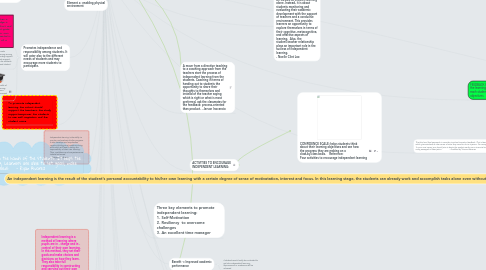Independent Learning
作者:Vierneskwela LAC Videos


1. When skills are develop, it will yield to: 1. Improved academic performance; 2. increased motivation and confidence; 3. greater students awareness of their limitations and their ability to manage them; 4. enabling teachers to provide differentiated tasks for students; and 5. fostering social inclusion by countering alienation.
2. LEARNING:SKILLS NEEDED: Cognitive, Metacognitive, Affective
3. Independent learning also includes both internal and external factors that will encourage the learners to practice/improve self-monitoring. - Hanna Legaspi
4. COGNITIVE SKILLS include developing informal rules for problem solving, classifying object, forming hypothesis, and reasoning logically.
5. - appropriate physical environment - flexible approach to time - shared willingness to undertake independent learning
6. METACOGNITIVE SKILLS include the ability to describe how they learn and the ability to reflect and self-monitor.
7. AFFECTIVE SKILLS include motivation and delayed gratification.
8. Independent learning does not necessariyl means working alone
9. Element 1. Shift of responsibility for the learning process
9.1. student-centered
10. Element 4: enabling physical environment
11. Element 2: Self-regulation; self-motivation
11.1. Ownership
11.2. Self-Directed
11.2.1. Step 1: Assess readiness to learn
11.2.1.1. Step 2: Set learning goals
11.3. self-monitor
11.3.1. Step 3: Engage in the learning process
11.3.1.1. Step 4: Evaluate learning
12. Promotes independence and responsibility among students. It will cater also to the different needs of students and may encourage more students to participate.
12.1. Independent learning is when a student acquires knowledge in his/her own pace or effort and develops the ability to set goals, monitor and evaluate their own learning. Feedback is essential in boosting the confidence of a student. - Josie Cadavos-
12.1.1. Element 3: Strong relationship between teachers and students
12.2. Schools can promote independent learning among students by including support for teachers, study support, empowering to use students self-regulation, and student voice.
12.3. some of the benefits of independent learning: improved academic performance, increased motivation and confidence
13. To promote independent learning, the school should support the teachers, the study support,empower the students to use self-regulation, and the student voice.
14. The ICT play an important role in independent learning because it offer opportunities for the easy assessment and measurement of self-directed learning, it increase the speed of access of information, and it provide a medium for interaction between learners and between learners and their teachers.
15. Independent learning is the ability to monitor and evaluate his/her progress. It also develops and emphasizes creative thinking and problem solving skills which will lead to taking the responsibility of their own learning. Thus, confidence and competence are indeed enhanced. --- Mayette R. Abante
16. Independent learning is a strategy wherein learning is in the hands of the students. It helps the students to develop responsibility for his/her own learning. Learners are able to set goals, make choices, and decide on how to meet his/her own learning needs. - Ryan Alvarez
17. Teachers can promote independent learning by building a supportive environment, providing students with the opportunity to monitor themselves, and provide feedback on homework to improve confidence.
17.1. Teacher can provide students an opportunity to the learners for self monitoring and work independently.
17.1.1. Teacher should see to it that the skill of the student in cognitive, metacognitive and affective should also address in idependent learning.
17.1.2. How School Promote independent learning?
18. Independent learning is a method of learning where pupils are in - charge and in - control of their own learning. In this method, they set their goals and make choices and decisions on how they learn. They also take full responsibility in constructing and carrying out their own learning, monitoring their progress and assessing their learning outcomes. One can become an independent learner when he is motivated to undertake such endeavor. He should also be strong and tough enough in overcoming challenges that may come his way. And lastly, independent learning is only possible when one knows how to manage his time because if not, independent learning will be a failure. ****Katherine M. Villostas
19. An independent learning is the result of the student's personal accountability to his/her own learning with a certain degree of sense of motivatation, interest and focus. In this learning stage, the students can already work and accomplish tasks alone even without the presence of a teacher or a parent for they have a clear vision and purpose of doing such things. - Joy Dalinas
20. In order to develop this skills teachers should design strategies to support independent learning through: 1. scaffolding; 2. providing students opportunities to self-monitor; 3. offering models of behavior; 4. developing communication that included language focused on learning; and 5. providing feedback on homework.
21. independent learning would be possible if students are highly motivated through interactive activities using different apps available.
22. a,s
23. Models for Self-learning
23.1. Planning
23.2. Self-monitoring
23.3. Controlling the Pace and Direction of the Work
23.4. Evaluation
24. The teachers can promote independent learning through different strategies such as scaffolding, providing students with opportunities to self- monitor, offering models of behavior, developing communications that included language focused on learning and providing feedback on homework.
25. CONFIDENCE SCALE: helps students think about their learning objectives and see how the progress they are making on a class-by-class basis. Reference: Four activities to encourage independent learning
26. FEEDBACK FOCUS - personalizes the learning development by having each students focus on their own objectives
26.1. RECORD AND REFLECT - students reflect on their own progress and performances
26.1.1. WRITTEN FEEDBACK-it is still important to give teacher's feedback so that student can track their progress , knows what to do next and it also helps to boost their confidence.
